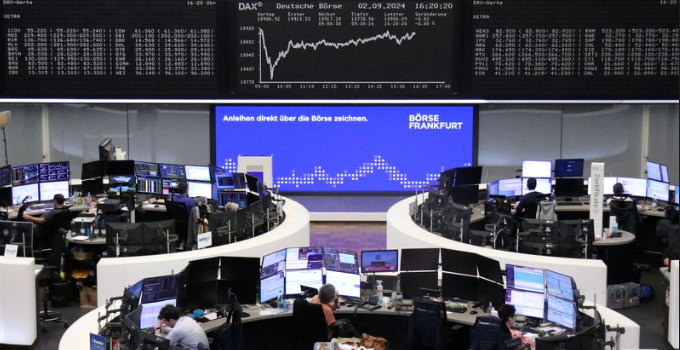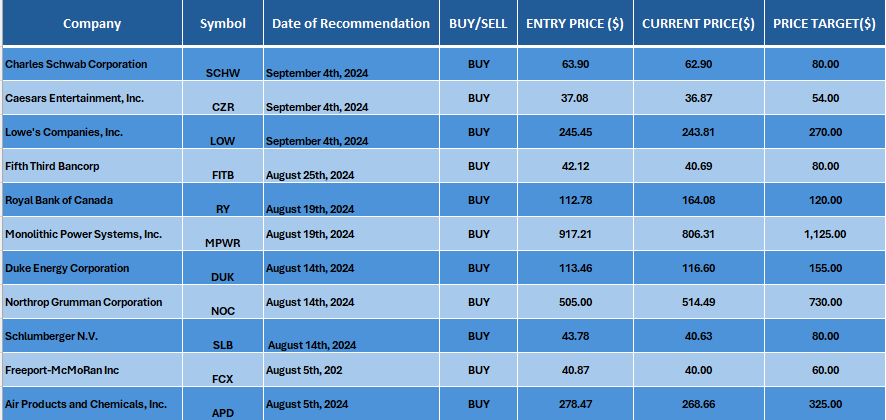
Date Issued – 24th September 2024
DAX Index Analysis: German PMI Ignites ECB Rate Cut Speculation – Market Forecast & Outlook
Market Overview
On Monday, September 23, the DAX index saw a 0.68% rise, partially recovering from the previous session’s 1.49% decline, closing at 18,847. This uptick was driven by renewed optimism regarding an ECB rate cut in Q4 2024.
Key DAX Market Movers
Leading the gains, Zalando SE surged by 3.17%, while Siemens Energy AG posted a 2.88% increase as expectations of lower interest rates bolstered investor sentiment. The auto sector also benefited from the prospect of cheaper borrowing, with BMW up by 2.44%, Volkswagen by 2.14%, and Mercedes-Benz Group advancing 2.00%. However, Commerzbank faced a significant setback, plummeting 5.68% after the German government expressed opposition to UniCredit’s acquisition plans.
German Private Sector PMIs Fuel Rate Cut Bets
Private sector PMI data released on September 23 stoked expectations of a forthcoming rate cut. The HCOB Manufacturing PMI fell sharply to 40.3 in September from 42.4 in August, marking a 12-month low and underscoring weakening demand in Germany’s industrial base. The HCOB Services PMI also dipped, falling to a six-month low of 50.6 from 51.2 in August, highlighting a broader slowdown in economic activity. Hamburg Commercial Bank’s Chief Economist, Dr. Cyrus de la Rubia, commented: “The manufacturing downturn is now spilling over into the services sector. Service sector growth has slowed for four consecutive months, edging closer to stagnation. Companies continue to cut jobs in response to falling demand, and the outlook for the services sector looks bleak.”
German Ifo Business Climate in Focus
On Tuesday, September 24, all eyes will be on Germany’s Ifo Business Climate Index. Economists anticipate a drop from 86.6 in August to 86.1 in September, which would further align with the private sector PMI results. A steeper decline could heighten pressure on the ECB to consider rate cuts, possibly boosting the DAX toward the 19,000 level.
Expert Views on Eurozone Economy and ECB Policy
Daniel Kral, Macro Specialist for Europe at Oxford Economics, shared insights on the Eurozone’s broader economic landscape: “September’s composite PMI for the Eurozone entered contraction, driven in part by the fading impact of the Paris Olympics. Downside risks are escalating as Europe faces fiscal tightening while the ECB remains behind the curve.”
US Economic Developments and Impact
In the US, the S&P Global Services PMI, a key economic indicator, marginally decreased to 55.4 in September from 55.7 in August, allaying concerns of a hard landing. With services comprising almost 80% of the US economy, this slight decline suggests resilience.
US Market Performance
On Monday, US equity markets posted modest gains. The S&P 500 advanced by 0.28%, while the Dow Jones and Nasdaq Composite rose 0.15% and 0.14%, respectively.
US Economic Calendar: Consumer Confidence in Focus
On Tuesday, US consumer confidence data will be critical for market direction. Analysts expect the Consumer Confidence Index to rise to 103.8 in September, up from 103.3 in August. A stronger-than-expected report could bolster optimism for a soft US economic landing, which in turn may provide upward momentum for the DAX toward the 19,000 mark. Conversely, if consumer confidence falters and dips below 100, fears of an economic slowdown could resurface, potentially dragging the DAX back toward 18,500.
Near-Term DAX Outlook
Short-term DAX trends will hinge on US consumer confidence data and central bank rhetoric. Stronger-than-expected data from the US, alongside growing support for rate cuts from both the ECB and Federal Reserve, could push the DAX to test 19,000. However, disappointing consumer sentiment could reignite fears of a hard landing in the US, which may drive the DAX lower. At the start of Tuesday’s session, futures are pointing to a mixed day, with DAX futures up 28 points while Nasdaq mini futures are down by 25 points. Investors should remain vigilant to central bank commentary and macroeconomic indicators.
DAX Technical Analysis
The DAX continues to trade above both its 50-day and 200-day EMAs, signaling bullish momentum. A breakout above 18,850 could pave the way for a rally toward the September 19 peak of 19,045, with a potential push to 19,200 if positive sentiment holds. On the downside, a dip below 18,750 would bring the 50-day EMA into play. The 14-day RSI of 57.76 suggests there is room for further upside before the index enters overbought territory.
Investor Appetite for Small Caps on the Rise Following Fed Rate Cut, Citi Reports
Citi’s latest weekly market analysis highlights a growing interest in small-cap stocks, particularly the Russell 2000 index, in the wake of the Federal Reserve’s recent rate cut. Investors have been expanding their long positions in the Russell 2000, with short sellers facing an average loss of 5.7%. According to Citi strategists, a potential short squeeze could push the index higher in the near term. The broader US equity landscape also showed signs of overextension, especially in the S&P 500, while investor sentiment toward the Nasdaq 100 remained neutral with balanced positioning. Citi noted that market volatility spiked following the Fed’s 50-basis-point cut, but US futures markets quickly rebounded overnight, buoyed by strong inflows into exchange-traded funds (ETFs) and fresh long positions.
“Last week’s volatility was further heightened by Triple Witching, which drove significant roll activity alongside the FOMC’s rate decision,” Citi strategists explained. Despite the rally in US markets, investor risk appetite continues to show divergence. Inflows into US equities were robust, yet cautious sentiment lingered, as demonstrated by varied flows across different sectors.
Global Market Positioning
Outside the US, investor positioning in Europe remained neutral, with mixed flows in the Eurostoxx index. Although ETF inflows were steady, they lacked a clear directional trend. Meanwhile, in Asia, positioning in Europe, Australasia, and the Far East (EAFE) and emerging market (EM) futures saw unusually large shifts, even accounting for the roll week. EM futures moved from neutral to the third most extended long position, while EAFE futures transitioned from mildly bullish to the second most extended short. In China, the sentiment was mixed. For China A50 futures, net positioning stayed heavily bearish (-2.2 normalized), although a bullish trend began to emerge as investors started adding long positions to balance previously profitable shorts. Conversely, most short positions in the Hang Seng had already been unwound, leaving the market largely long, with average long positions showing a 4.2% gain.
Conclusion
Citi’s strategists suggest that the growing appetite for small caps and the evolving positioning trends in global markets could create new opportunities for investors. However, with volatility still elevated and key sectors showing divergence, caution is warranted as market participants navigate the changing macroeconomic environment.

JPMorgan Optimistic on Growth in India and Japan, Targets Southeast Asia for Expansion
JPMorgan Chase & Co. (NYSE: JPM), the largest bank in the United States, has expressed a bullish outlook on growth prospects in India and Japan, while also exploring Southeast Asia as part of its “China Plus One” strategy, according to a report from Reuters. In an interview with Reuters, Sjoerd Leenart, JPMorgan’s Asia Pacific CEO, highlighted India’s position as one of the bank’s top three, if not top two, markets in Asia, alongside Japan. India’s growth, he noted, is “very broad-based,” and JPMorgan is actively increasing its investment in the country. This includes expanding its banking team, boosting capital allocation, and enhancing technological capabilities to serve new market segments.
JPMorgan’s commercial banking division in India, which primarily serves mid-sized businesses, is projected to expand by up to 30% in the coming years. However, Leenart emphasized the need for India to further develop its manufacturing ecosystem in order to fully leverage the opportunities presented by the “China Plus One” strategy. While scaling this ecosystem presents a challenge, JPMorgan remains optimistic about India’s potential to succeed. Regarding Japan, Leenart pointed to the recent shift toward positive interest rates, which has sparked renewed client interest in the market. This shift presents opportunities for corporate activity as well as interest rate-driven investments, making Japan an attractive market for growth. Despite concerns over China’s slowing economic momentum, Leenart underscored that JPMorgan’s operations in China continue to expand. The bank is also eyeing Southeast Asia for future investment opportunities. Although the region’s fragmented nature poses challenges, its combined economies, valued at nearly $3 trillion, represent a significant growth potential for JPMorgan. Leenart’s remarks reflect JPMorgan’s strategic focus on diversifying its investments across Asia, balancing growth opportunities in India, Japan, and Southeast Asia while maintaining a presence in China amid shifting global economic dynamics.
Boeing’s ‘Best And Final Offer’ Met With Union Resistance Amid Striking Worker Tensions
Boeing has presented a “best and final offer” to its striking factory workers, promising significant raises and bonuses. However, the International Association of Machinists and Aerospace Workers (IAM) District 751, the union leading the strike, has pushed back, accusing the aerospace giant of attempting to bypass the negotiation process and create divisions among workers. In a public statement, the union criticized Boeing for releasing the offer directly to workers and the media, without involving the union’s negotiating team. According to IAM District 751, the negotiating team was still in the process of reviewing the offer when it was released. The union further stated that the mediation process collapsed on September 18, when Boeing refused to address key priorities raised by union members.
Boeing’s new offer includes a 30% pay raise over four years an increase from its initial 25% offer, but still below the union’s demand for 40%. Additionally, the offer doubles the ratification bonus to $6,000 and reinstates an annual productivity bonus that was previously excluded. However, Boeing has made the offer contingent upon the union workers voting to ratify it by Friday night, a deadline that the union leadership has rejected, arguing it does not provide sufficient time to inform members or arrange voting locations. The union also claims Boeing misled the media by implying that the union members are obligated to vote on the latest proposal. The union’s statement further emphasized that the proposal does not adequately address the workers’ concerns and falls short of the union’s expectations.
Key Quote
The union strongly criticized Boeing’s approach, stating: “They are trying to drive a wedge between our members and weaken our solidarity with this divisive strategy. This tactic is a blatant show of disrespect to you our members and the bargaining process. Boeing does not get to decide when or if you vote.”
By the Numbers
33,000: The number of unionized Boeing factory workers in the Pacific Northwest currently participating in the strike.
Background
Earlier this month, Boeing appeared to be on the verge of an agreement with the union, offering a 25% wage increase over four years, lower healthcare costs, and a commitment to build its next airplane in Washington state. However, on September 12, IAM districts 751 and W24 announced that their members had overwhelmingly rejected the contract offer, with 94.6% voting against it and 96% supporting strike action. The ongoing strike has halted most commercial aircraft production, and Boeing has been forced to furlough its executives, managers, and other white-collar employees one week out of every four during the strike. The strike and continued negotiations highlight the growing tension between Boeing and its workforce, as both sides grapple with wage expectations, production demands, and broader concerns over labor relations in the manufacturing sector.
NewHydrogen CEO and Dartmouth Energy Expert Discuss Nanomanufacturing and 2D Materials for Energy
In a recent podcast, NewHydrogen, Inc. CEO Steve Hill and Dartmouth’s Dr. William Scheideler explored advances in scalable nanomanufacturing and energy technologies like Perovskite solar cells and green hydrogen production. NewHydrogen’s ThermoLoop™ technology, a process that uses water and heat to produce low-cost green hydrogen, was a central focus of the discussion, emphasizing its potential to revolutionize the green hydrogen market by reducing reliance on expensive electricity. Dr. Scheideler, an expert in energy materials, shared insights on his research involving earth-abundant materials for electrocatalysis, aimed at replacing costly platinum and iridium catalysts in hydrogen production. His group’s work seeks to increase efficiency in hydrogen generation by organizing hydrogen and oxygen bubbles during electrolysis, improving overall energy use.
The conversation also touched on the limitations of battery storage for renewable energy, with Dr. Scheideler advocating for hydrogen as a more scalable solution for storing excess renewable energy generated from sources like wind and solar. This view aligns with the U.S. Department of Energy’s target of producing hydrogen at $1/kg using affordable materials and efficient processes. ThermoLoop™ further aims to cut the cost of hydrogen by utilizing heat from concentrated solar, geothermal, nuclear reactors, or industrial waste, eliminating the need for expensive green electricity. NewHydrogen’s goal is to significantly reduce the cost of producing green hydrogen and contribute to the broader adoption of a hydrogen economy, a market estimated to reach $12 trillion, according to Goldman Sachs.
Find below some of our Buy/Sell Recommendations. Balfour Capital Group is a distinguished global boutique investment management firm with $400 million AUM and over 1000 Clients.

Disclaimer: This post provides financial insights for informational purposes only. It does not constitute financial advice or recommendations for investment decisions.

